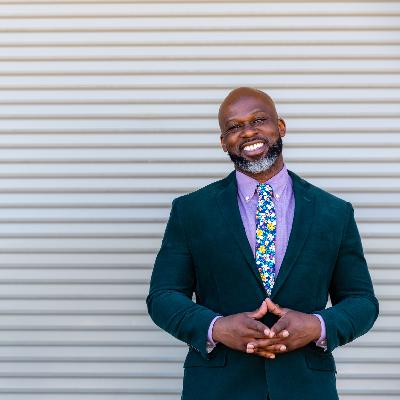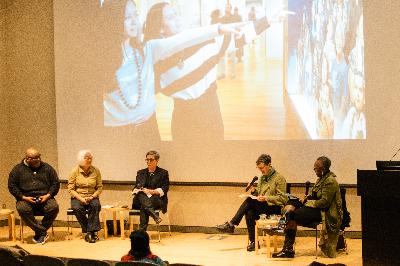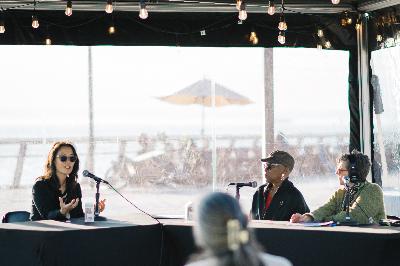Discover doubleXposure Podcast
doubleXposure Podcast

doubleXposure Podcast
Author: Marcie Sillman and Vivian Phillips
Subscribed: 4Played: 6Subscribe
Share
© @Vivian Phillips and Marcie Sillman
Description
Seattle arts veterans Vivian Phillips and Marcie Sillman plumb the deepest depths and the tiniest cracks of our world to understand how culture and creativity shape our lives, sometimes in ways we don't even see.
56 Episodes
Reverse
Theresa Ruth Howard fell in love with ballet as a little girl. And she was one of the aspiring ballerinas who got to live her dream. Howard went on to write about dance, and ultimately, to work with ballet companies that aspired to open the rarified art form to a more diverse pool of both dancers and audience members. Howard is also the founder of Memoirs of Blacks in Ballet, a project that seeks to make Black dancers' stories accessible to a wider audience. Vivian and Marcie spoke with Howard about her work, and about her vision for ballet in the 21st century and beyond.
Dr. Quinton Morris is a violinist, a fully tenured professor music at Seattle University, a radio host, arts advocate and mentor to young people who might not get the opportunity to study classical music. Morris didn't set out the become a performing artist, but when he got to college, he reinvented his future. Now, Morris wears more hats than most people, and works tirelessly for both artists and the arts. Co-hosts Vivian Phillips and Marcie Sillman sat down with Quinton Morris to learn about his backstory, and about his vision for the future.
Nia-Amina Minor was little more than a toddler when she started entertaining her family with little dances she'd create and perform in their living room. After training at the Debbie Allen Dance Academy in Los Angeles, Minor thought she's leave dance behind when she entered Stanford University. Instead, Minor pursued a graduate degree in dance, moved to Seattle to join Spectrum Dance Theatre, and has evolved into one of the city's most versatile teachers, dancemakers and visionary artists. She shares her story, and her dreams of building a thriving West Coast artistic community, with co-hosts Marcie Sillman and Vivian Phillips.
When barry johnson was a kid in Kansas, he knew he wanted to be an artist, but he didn't see people that looked like him creating paintings or sculptures.. johnson moved to Seattle after college for a job in the regional tech industry. Every day on the bus to work, he'd pull out his sketch book, pull out his headphones and draw. Now this self-taught artist is one of the biggest names in Seattle's creative community. For johnson, making art is as much about telling the stories of his community as it is self-expression. And the artist plans to keep it that way as he tells co-hosts Vivian Phillips and Marcie Sillman.
When Preston Singletary was growing up in Seattle in the 1970's and '80's, he dreamed of being a professional musicians. But when he went over to hang out with his buddy after school. Singletary's life took a different path. His friend, Dante Marioni's dad Paul was part pf Seattle's thriving art glass movement, and young Preston found himself drawn to the art form. More than 40 years later, Singletary has become one of the world's most famous glass artists, pioneering techniques that allow him to replicate Northwest Indigenous designs, and to transmit the stories of his Tlingit ancestors. Co-hosts Marcie Sillman and Vivian Phillips paid a visit to Singletary's studio, located in the middle of the Seattle campus of the Fred Hutchinson Cancer Research Center to talk about craft and legacy and the importance of cultural stories.
When Nataki Garrett became the artistic director of Oregon Shakespeare Festival, the future looked bright. That was 2019. Garrett's tenure was marred by COVID 19, and wildfires that forced the shutdown of OSF's large outdoor theater. OSF, like most nonprofit arts organizations, suffered from revenue losses that challenged Garrett and her colleagues. Unfortunately, the pressures finally pushed Garrett to resign her post. Co-hosts Marcie Sillman and Vivian Phillips talked with Garrett about what happened to her in Ashland, and whether she has hope for the future of American theater.
Justin Huertas has had quite a year: his first musical theater piece, Lizard Boy, had an off-Broadway run. His latest work, Lydia and the Troll, debuted to critical and audience acclaim at Seattle Repertory Theatre. And Huertas shepherded another musical onto the Kennedy Center stage: The Mortification of Fovea Munson. Huertas' shows are lively and fun, but they are steeped in his passion to showcase the stories of people who aren't typically featured onstage or on screen, stories he didn't get to see when he was growing up. He's creating fantasties and legends for the global majority. Despite his artistic success, and his dream of bringing more original shows to New York, Huertas is still devoted to the Seattle area, where he grew up. He spoke to co-hosts Vivian Phillips and Marcie Sillman about the joy--and pride--he takes in his work.
When Megan Griffiths finished film school she didn't head to New York or Los Angeles. Griffiths decided to make movies in Seattle after falling in love with the city's music scene in the early 1990's. Griffiths has built a career making both independent feature films in Washington State and directing bigger budget television shows in Hollywood but her heart belongs to Seattle. The filmmaker, sidelined by the Writer's Guild of America strike, took some time to talk about her movies and Seattle's film community, with co-hosts Marcie Sillman and Vivian Phillips.
Marc Bamuthi Joseph has been involved in the creative sphere ever since he was a boy in Queens. The son of Haitian immigrants, Joseph knew he had an ancestral debt to pay, and he didn't intend to squander his opportunity. A dancer, a spoken-word poet, a playwright and leader of social impact for the Kennedy Center, as well as a Global TED Fellow, Joseph recognizes arts potential to touch and change lives. "I just don't trust art that doesn't bleed, or sweat or cry," he says. In this episode, Marc Bamuthi Joseph talks to co-hosts Vivian Phillips and Marcie Sillman about how his family helped pave the way for his current path, and what he hopes his audiences will take away from his work.
In late 2022, Seattle Art Museum welcomed audiences into its newly-reimagined American Art galleries. SAM, like many cultural institutions, has been revamping not only how it selects and presents art to the public; it is reassessing who the "public" really is, and how to create a curatorial process that welcomes in community members who haven't had access to big museums like it. On March 1, 2023, co-hosts Vivian Phillips and Marcie Sillman moderated a panel that included Seattle Art Museum American art curator Theresa Papanikolas; writer and advocate Mayumi Tsutakawa; and Inye Wokoma, artist, writer, curator and co-founder of Wa Na Wari. We recorded this wide-ranging conversation in front of a live audience.
We wrap our second season with this live recording from WaNaWari, a cultural space in the heart of Seattle's Central District. Once upon a time, artist and WaNaWari co-founder Inye Wokoma's family lived in this house. In 2019, Wokoma and three collaborators transformed the building into art galleries. But WaNaWari is more than a destination; it houses a free food program, a community oral history project, and an on-going effort to document how Seattle's land use policies have affected the neighborhood's historically Black population. Co-hosts Vivian Phillips and Marcie Sillman wrapped a season-long exploration of the ties between culture and community with these interviews, taped in front of a live audience on December 14, 2022.
Kristina Clark spent years dreaming about making a space for Black literature, community and healing. This year she finally took the leap and opened the Loving Room in Seattle's Central District. The Loving Room is a business, but Clark says beyond that, it's a place for the Black community to gather together, to feel at home. She's proud that her new business is part of a wider movement by Black entrepreneurs to reclaim and re-establish a strong community-led business and cultural district. Co-hosts Vivian Phillips and Marcie Sillman talked to Clark about how she transformed her dream into reality, and what it will take to keep it alive.
Most Seattleites know Donna Moodie as the owner of the beloved restaurant Marjorie, named for her mother. But during the pandemic, Moodie decided her restaurant could operate without her full-time presence. Now she's heading up Community Roots Housing, advocating for affordable--and dignified--housing for everyone. Moodie believes deeply in building community, whether that means in bricks and mortar developments, or over a dinner table. Join co-hosts Vivian Phillips and Marcie Sillman for a conversation with Donna Moodie that's sure to light up your day.
Seattle's Central Area (or as some people know it, the Central District) is the historic home of the city's African American community. Although skyrocketing real estate prices have forced many to leave the neighborhood, city planners are working hard to try to restore the Central Area to its roots. As head of Seattle's Office of Planning and Community Development architect Rico Quirindongo plays a key role in this work. Quirindongo is a Central Area native who returned to his hometown to help recreate a city that everyone, especially BIPOC residents, can call home.
When the Viaduct--Seattle's aging elevated waterfront highway--came down three years ago, it ushered in a intense, five-year redevelopment project on the shores of Elliott Bay, the ancestral home of the Coast Salish people and the historic launching pad for present-day Seattle. In addition to a new passenger ferry terminal, a tree-lined boulevard with bicycle lanes, and pedestrian walkways from downtown Seattle to the waterfront, the redevelopment includes a 20-acre park and more than a dozen public artworks. Co-hosts Vivian Phillips and Marcie Sillman invited an audience to join them at Pier 62, the heart of the new park, for a series of conversations about the waterfront's history, its cultural future, and how the new project could reshape Seattle's identity.
More than 50 years ago, in the aftermath of Dr. Martin Luther King Jr.'s assassination, New York City Ballet dancer Arthur Mitchell found himself wondering how he, an artist, could help foster social and racial equity. His answer, with Karel Shook, was to found Dance Theatre of Harlem, originally a school program based in Mitchell's home neighborhood. Not long after, Mitchell and Shook expanded their vision to create a touring ballet company that could show the world that the classical art form wasn't just for white Europeans. Virginia Johnson was part of the original company; now Johnson is in her final season as DTH's artistic director. She talks with co-hosts Vivian Phillips and Marcie Sillman about DTH and the power of art to change the world.
For years Seattle residents and visitors have had a hard time getting from the downtown streets to the city's waterfront. In November, 2019, one of the biggest impediments to access, the double decker elevated Viaduct highway, came down, making way for a new surface street, pedestrian and bicycle trails, a 20-acre park, and a slew of new public artworks. Seattle was one of the first cities in the country to implement a law that requires one percent of public works projects to fund art to be locate at the project. In the case of the waterfront redevelopment, that money will pay for everything from art installations focused on the sea itself, to works that highlight the history and culture of the Indigenous people who have called the area home for many centuries. Ruri Yampolsky is in charge of stewarding the creation and installation of these public artworks. She talks with Vivian Phillips and Marcie Sillman about what we'll see when the dust finally settles at one of the biggest redevelopment sites in Seattle history.
The City of Seattle is in the middle of a major waterfront redevelopment project, including creation of a 20-acre park. But it won't be the first urban park built on Seattle's downtown shoreline. 15 years ago, Seattle Art Museum inaugurated its Olympic Sculpture Park, an art-filled haven on Elliott Bay, just north of Seattle's downtown core. The 9-acre urban oasis includes not only a notable sculpture collection but also beach access and an all-seasons pavilion. Best of all, its open free-of-charge seven days a week. Seattle Art Museum Director Amada Cruz talked to Vivian and Marcie about the Sculpture Park's mission, its connection to community, and what will change when the adjacent waterfront park opens in 2025.
Co-hosts Vivian Phillips and Marcie Sillman start their exploration of how culture fits into the massive redevelopment of Seattle's downtown waterfront at Pier 62. It's the first finished section of what will be a 20-acre park where a double decker highway once stood. Overseeing the park's development is the nonprofit group Friends of Waterfront Seattle. Chief Operating Officer Eldon Tam explains the vision for this new park and how the community is helping to shape it.
Artists create work to express themselves, to communicate with an audience, and in the case of Jake Prendez and Angelina Villalobos, to sustain their culture. This season co-hosts Vivian and Phillips and Marcie Sillman are exploring the ways that art can build community. Today, in the fourth episode in Seattle's South Park neighborhood, they talk with Prendez and Villalobos in front of a live audience at community-owned South Park Hall.




















